ESP TOYOTA GR YARIS 2021 User Guide
[x] Cancel search | Manufacturer: TOYOTA, Model Year: 2021, Model line: GR YARIS, Model: TOYOTA GR YARIS 2021Pages: 458, PDF Size: 105.69 MB
Page 119 of 458

117
3
YARIS(GR) Owner's Manual_Europe_M52L09_en
3-3. Adjusting the seats
Before driving
■Front seats
1 Up
Pull the head restraint up.
2Down
Push the head restraint down while
pressing the lock release button .
WARNING
●Do not allow children to enter the luggage compartment.
●Do not allow anyone to sit on the rear center seat if the rear right seat
is folded down, as the seat belt buckle for the rear center seat belt is then concealed under the folded
seat and cannot be used.
●Be careful not to get your hand
caught when folding the rear seat- backs.
●Adjust the position of the front seats before folding down the rear seat-backs so that the front seats do not
interfere with the rear seatbacks when folding down the rear seat-backs.
■After returning the rear seatback to the upright position
●Make sure that the seatback is securely locked in position by lightly pushing it back and forth.
If the seatback is not securely locked,
the red marking will be visible on the
seatback lock release lever. Make
sure that the red mark is not visible.
Head restraints
Head restraints are provided
for all seats.
WARNING
■Head restraint precautions
Observe the following precautions
regarding the head restraints. Failure to do so may result in death or serious injury.
●Use the head restraints designed for each respective seat.
●Adjust the head restraints to the correct position at all times.
●After adjusting the head restraints, push down on them and make sure
they are locked in position.
●Do not drive with the head
restraints removed.
Adjusting a head restraint
Page 123 of 458

121
3
YARIS(GR) Owner's Manual_Europe_M52L09_en
3-4. Adjusting the steering wheel and mirrors
Before driving
The height of the rear view mirror
can be adjusted to suit your driving
posture.
Adjust the height of the rear view
mirror by moving it up and down.
Responding to the level of bright-
ness of the headlights of vehicles
behind, the reflected light is auto-
matically reduced.
Changing automatic anti-glare
function mode on/off
When the automatic anti-glare function
is in ON mode, the indicator illumi-
nates. The function will set to ON mode
each time the engine switch is turned to
ON.
Pressing the button turns the function
to off mode. (The indicator also
turns off.)
■To prevent sensor error
To ensure that the sensors operate properly, do not touch or cover them.
Inside rear view mirror
The rear view mirror’s position
can be adjusted to enable suf-
ficient confirmation of the rear
view.
Adjusting the height of rear
view mirror
WARNING
■Caution while driving
Do not adjust the position of the mir-
ror while driving. Doing so may lead to mishandling of the vehicle and cause an accident,
resulting in death or serious injury.
Anti-glare function
Page 127 of 458
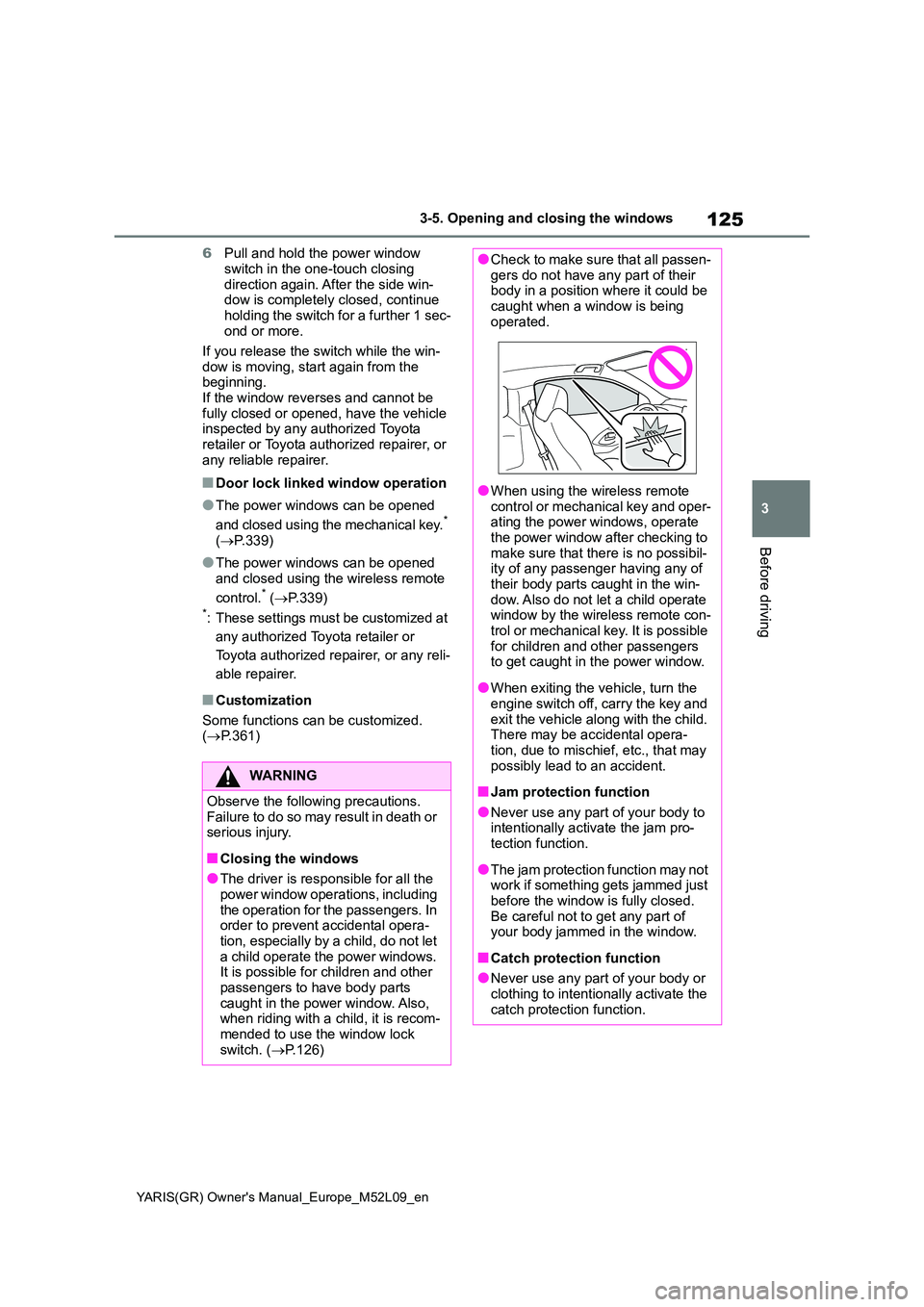
125
3
YARIS(GR) Owner's Manual_Europe_M52L09_en
3-5. Opening and closing the windows
Before driving
6Pull and hold the power window
switch in the one-touch closing direction again. After the side win-dow is completely closed, continue
holding the switch for a further 1 sec- ond or more.
If you release the switch while the win-
dow is moving, start again from the beginning.If the window reverses and cannot be
fully closed or opened, have the vehicle inspected by any authorized Toyota retailer or Toyota authorized repairer, or
any reliable repairer.
■Door lock linked window operation
●The power windows can be opened
and closed using the mechanical key.* ( →P.339)
●The power windows can be opened
and closed using the wireless remote
control.* ( →P.339)*: These settings must be customized at
any authorized Toyota retailer or
Toyota authorized repairer, or any reli-
able repairer.
■Customization
Some functions can be customized. ( →P.361)
WARNING
Observe the following precautions. Failure to do so may result in death or serious injury.
■Closing the windows
●The driver is responsible for all the
power window operations, including the operation for the passengers. In order to prevent accidental opera-
tion, especially by a child, do not let a child operate the power windows. It is possible for children and other
passengers to have body parts caught in the power window. Also, when riding with a child, it is recom-
mended to use the window lock switch. ( →P.126)
●Check to make sure that all passen- gers do not have any part of their body in a position where it could be
caught when a window is being operated.
●When using the wireless remote control or mechanical key and oper-ating the power windows, operate
the power window after checking to make sure that there is no possibil-ity of any passenger having any of
their body parts caught in the win- dow. Also do not let a child operate window by the wireless remote con-
trol or mechanical key. It is possible for children and other passengers to get caught in the power window.
●When exiting the vehicle, turn the engine switch off, carry the key and
exit the vehicle along with the child. There may be accidental opera-tion, due to mischief, etc., that may
possibly lead to an accident.
■Jam protection function
●Never use any part of your body to intentionally activate the jam pro-tection function.
●The jam protection function may not work if something gets jammed just
before the window is fully closed. Be careful not to get any part of your body jammed in the window.
■Catch protection function
●Never use any part of your body or
clothing to intentionally activate the catch protection function.
Page 130 of 458

128
YARIS(GR) Owner's Manual_Europe_M52L09_en
4-1. Before driving
4- 1. B ef ore dr iv in g
■Starting the engine
→P. 1 3 6
■Driving
1While depressing the clutch
pedal, shift the shift lever to 1.
(→P.139)
2Release the parking brake.
(→P.143)
3Gradually release the clutch
pedal. At the same time, gently
depress the accelerator pedal to
accelerate the vehicle.
■Stopping
1While depressing the clutch
pedal, depress the brake pedal.
2If necessary, set the parking
brake.
If the vehicle is to be stopped for an
extended period of time, shift the shift
lever to N. (→P.139)
If the Stop & Start system is enabled,
shifting the shift lever to N and releas-
ing the clutch pedal will stop the engine.
(→P.196)
■Parking the vehicle
1While depressing the clutch
pedal, depress the brake pedal.
2Set the parking brake. (→P.143)
Check that the parking brake indicator is illuminated.
3Shift the shift lever to N.
(→P.139)
If parking on a hill, shift the shift lever to
1 or R and block the wheels as needed.
4Turn the engine switch to OFF
to stop the engine.
5Slowly release the brake pedal.
6Lock the door, making sure that
you have the key on your per-
son.
■Starting off on a steep uphill
1Make sure that the parking
brake is set and shift the shift
lever to 1.
2Lightly depress the accelerator
pedal at the same time as grad-
ually releasing the clutch pedal.
3Release the parking brake.
■Driving in the rain
●Drive carefully when it is raining,
because visibility will be reduced, the
windows may become fogged-up, and
the road will be slippery.
●Drive carefully when it starts to rain,
because the road surface will be
especially slippery.
●Refrain from high speeds when driv-
ing on an expressway in the rain,
because there may be a layer of water
between the tires and the road sur-
face, preventing the steering and
brakes from operating properly.
■Restraining the engine output
(Brake Override System)
●When the accelerator and brake ped-
als are depressed at the same time,
the engine output may be restrained.
●A warning message is displayed on
the multi-information display and
Driving the vehicle
The following procedures
should be observed to ensure
safe driving:
Driving procedure
Page 131 of 458
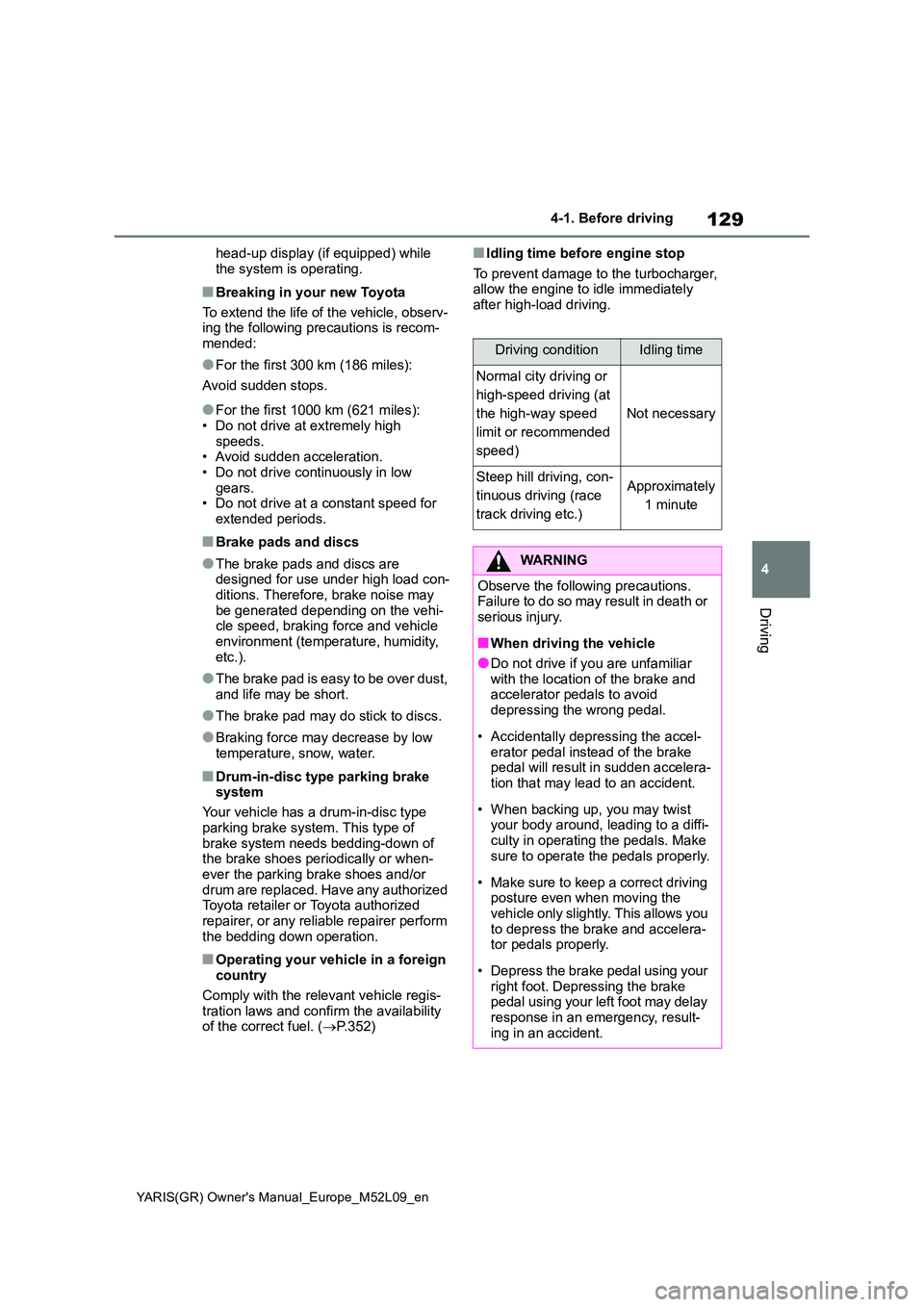
129
4
YARIS(GR) Owner's Manual_Europe_M52L09_en
4-1. Before driving
Driving
head-up display (if equipped) while
the system is operating.
■Breaking in your new Toyota
To extend the life of the vehicle, observ- ing the following precautions is recom-
mended:
●For the first 300 km (186 miles):
Avoid sudden stops.
●For the first 1000 km (621 miles): • Do not drive at extremely high
speeds. • Avoid sudden acceleration.• Do not drive continuously in low
gears. • Do not drive at a constant speed for extended periods.
■Brake pads and discs
●The brake pads and discs are designed for use under high load con-
ditions. Therefore, brake noise may be generated depending on the vehi-cle speed, braking force and vehicle
environment (temperature, humidity, etc.).
●The brake pad is easy to be over dust, and life may be short.
●The brake pad may do stick to discs.
●Braking force may decrease by low
temperature, snow, water.
■Drum-in-disc type parking brake system
Your vehicle has a drum-in-disc type
parking brake system. This type of brake system needs bedding-down of the brake shoes periodically or when-
ever the parking brake shoes and/or drum are replaced. Have any authorized Toyota retailer or Toyota authorized
repairer, or any reliable repairer perform the bedding down operation.
■Operating your vehicle in a foreign country
Comply with the relevant vehicle regis- tration laws and confirm the availability of the correct fuel. ( →P.352)
■Idling time before engine stop
To prevent damage to the turbocharger, allow the engine to idle immediately after high-load driving.
Driving conditionIdling time
Normal city driving or
high-speed driving (at
the high-way speed
limit or recommended
speed)
Not necessary
Steep hill driving, con-
tinuous driving (race
track driving etc.)
Approximately
1 minute
WARNING
Observe the following precautions. Failure to do so may result in death or
serious injury.
■When driving the vehicle
●Do not drive if you are unfamiliar with the location of the brake and accelerator pedals to avoid
depressing the wrong pedal.
• Accidentally depressing the accel-
erator pedal instead of the brake pedal will result in sudden accelera-tion that may lead to an accident.
• When backing up, you may twist your body around, leading to a diffi-
culty in operating the pedals. Make sure to operate the pedals properly.
• Make sure to keep a correct driving posture even when moving the vehicle only slightly. This allows you
to depress the brake and accelera- tor pedals properly.
• Depress the brake pedal using your right foot. Depressing the brake pedal using your left foot may delay
response in an emergency, result- ing in an accident.
Page 157 of 458

155
4
YARIS(GR) Owner's Manual_Europe_M52L09_en
4-5. Using the driving support systems
Driving
4-5.Using the d riving s upport sy ste ms
*: If equipped
■PCS (Pre-Collision System)
→ P. 1 6 0
■LTA (Lane Tracing Assist)
→ P. 1 7 2
■AHB (Automatic High Beam)
→ P. 1 4 7
■RSA (Road Sign Assist) (if
equipped)
→ P. 1 9 2
■Dynamic radar cruise control
→ P. 1 8 1
Two types of sensors, located
behind the front grille and wind-
shield, detect information neces-
sary to operate the drive assist
systems.
Radar sensor
Front camera
Toyota Safety Sense*
The Toyota Safety Sense con-
sists of the following drive
assist systems and contrib-
utes to a safe and comfortable
driving experience:
Driving assist system
WARNING
■Toyota Safety Sense
The Toyota Safety Sense is designed to operate under the assumption that the driver will drive safely, and is
designed to help reduce the impact to the occupants and the vehicle in the case of a collision or assist the driver
in normal driving conditions. As there is a limit to the degree of rec-ognition accuracy and control perfor-
mance that this system can provide, do not overly rely on this system. The driver is always responsible for paying
attention to the vehicle’s surroundings and driving safely.
Sensors
WARNING
■To avoid malfunction of the radar sensor
Observe the following precautions.
Otherwise, the radar sensor may not operate properly, possibly leading to an accident resulting in death or seri-
ous injury.
Page 164 of 458
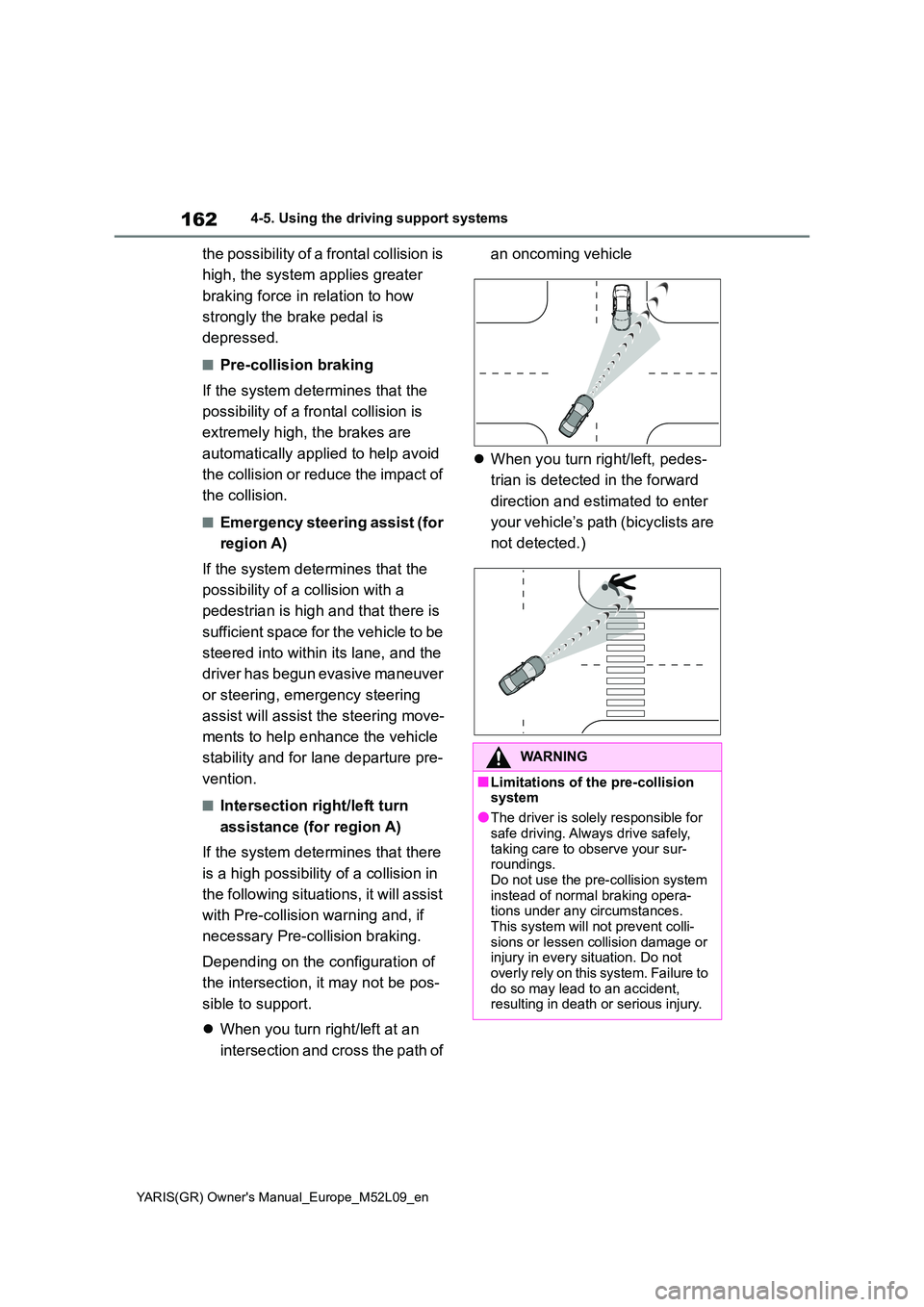
162
YARIS(GR) Owner's Manual_Europe_M52L09_en
4-5. Using the driving support systems
the possibility of a frontal collision is
high, the system applies greater
braking force in relation to how
strongly the brake pedal is
depressed.
■Pre-collision braking
If the system determines that the
possibility of a frontal collision is
extremely high, the brakes are
automatically applied to help avoid
the collision or reduce the impact of
the collision.
■Emergency steering assist (for
region A)
If the system determines that the
possibility of a collision with a
pedestrian is high and that there is
sufficient space for the vehicle to be
steered into within its lane, and the
driver has begun evasive maneuver
or steering, emergency steering
assist will assist the steering move-
ments to help enhance the vehicle
stability and for lane departure pre-
vention.
■Intersection right/left turn
assistance (for region A)
If the system determines that there
is a high possibility of a collision in
the following situations, it will assist
with Pre-collision warning and, if
necessary Pre-collision braking.
Depending on the configuration of
the intersection, it may not be pos-
sible to support.
�z When you turn right/left at an
intersection and cross the path of
an oncoming vehicle
�z When you turn right/left, pedes-
trian is detected in the forward
direction and estimated to enter
your vehicle’s path (bicyclists are
not detected.)
WARNING
■Limitations of the pre-collision system
●The driver is solely responsible for
safe driving. Always drive safely, taking care to observe your sur-roundings.
Do not use the pre-collision system instead of normal braking opera-tions under any circumstances.
This system will not prevent colli- sions or lessen collision damage or injury in every situation. Do not
overly rely on this system. Failure to do so may lead to an accident, resulting in death or serious injury.
Page 174 of 458
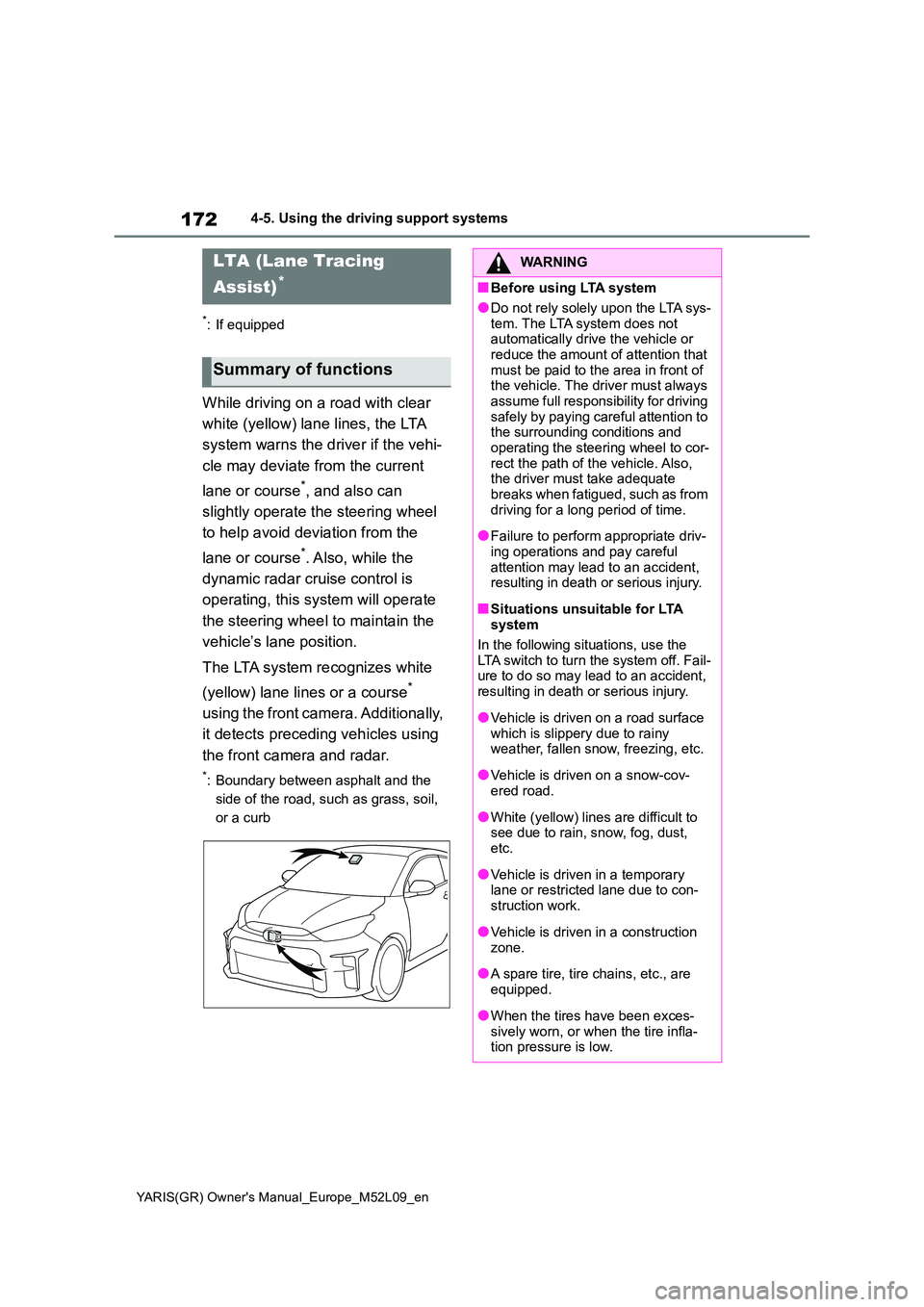
172
YARIS(GR) Owner's Manual_Europe_M52L09_en
4-5. Using the driving support systems
*: If equipped
While driving on a road with clear
white (yellow) lane lines, the LTA
system warns the driver if the vehi-
cle may deviate from the current
lane or course*, and also can
slightly operate the steering wheel
to help avoid deviation from the
lane or course*. Also, while the
dynamic radar cruise control is
operating, this system will operate
the steering wheel to maintain the
vehicle’s lane position.
The LTA system recognizes white
(yellow) lane lines or a course*
using the front camera. Additionally,
it detects preceding vehicles using
the front camera and radar.
*: Boundary between asphalt and the
side of the road, such as grass, soil,
or a curb
LTA (Lane Tracing
Assist)*
Summary of functions
WARNING
■Before using LTA system
●Do not rely solely upon the LTA sys-
tem. The LTA system does not automatically drive the vehicle or reduce the amount of attention that
must be paid to the area in front of the vehicle. The driver must always assume full responsibility for driving
safely by paying careful attention to the surrounding conditions and operating the steering wheel to cor-
rect the path of the vehicle. Also, the driver must take adequate breaks when fatigued, such as from
driving for a long period of time.
●Failure to perform appropriate driv-
ing operations and pay careful attention may lead to an accident, resulting in death or serious injury.
■Situations unsuitable for LTA system
In the following situations, use the LTA switch to turn the system off. Fail-ure to do so may lead to an accident,
resulting in death or serious injury.
●Vehicle is driven on a road surface
which is slippery due to rainy weather, fallen snow, freezing, etc.
●Vehicle is driven on a snow-cov-ered road.
●White (yellow) lines are difficult to see due to rain, snow, fog, dust, etc.
●Vehicle is driven in a temporary lane or restricted lane due to con-
struction work.
●Vehicle is driven in a construction
zone.
●A spare tire, tire chains, etc., are
equipped.
●When the tires have been exces-
sively worn, or when the tire infla- tion pressure is low.
Page 184 of 458
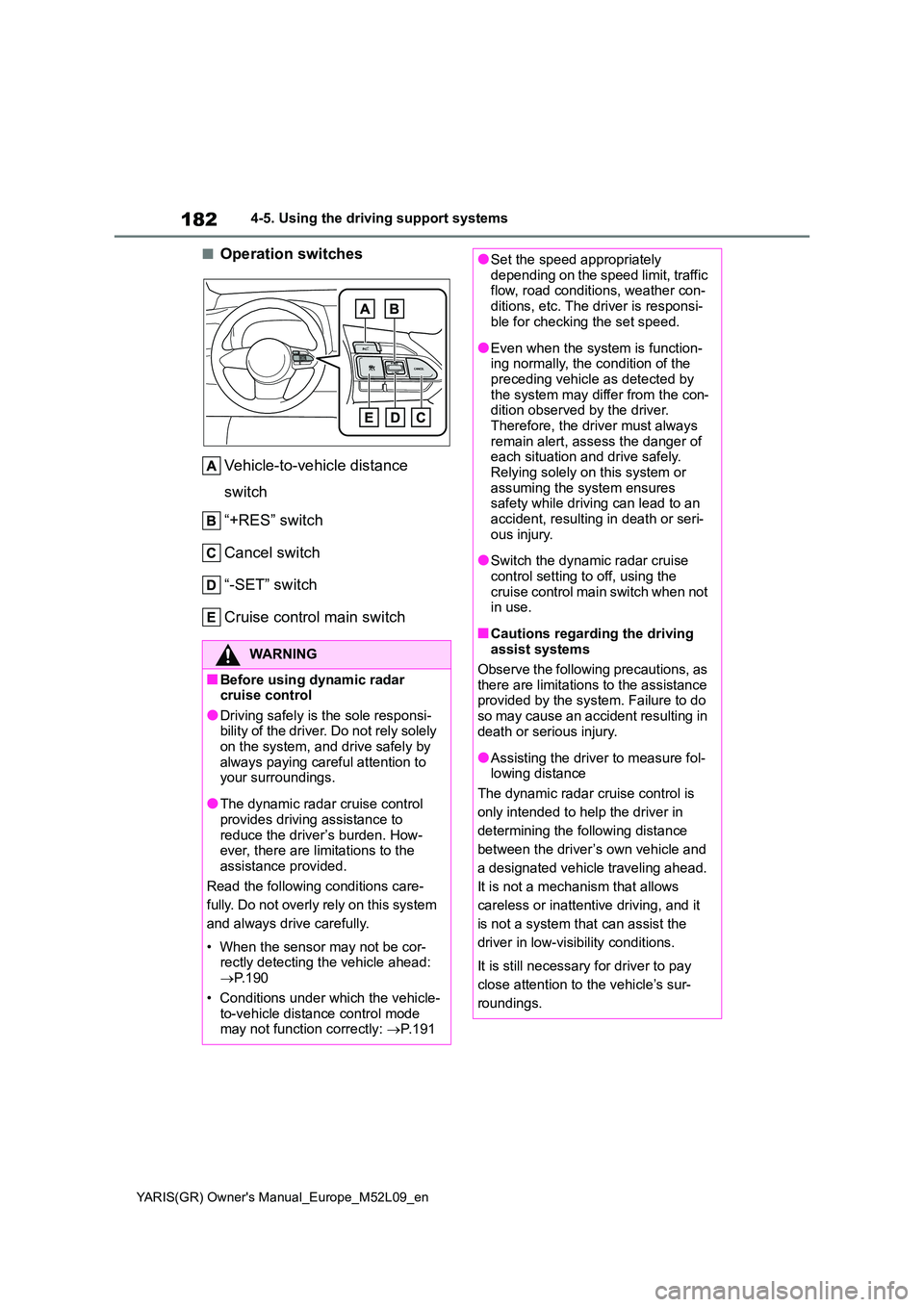
182
YARIS(GR) Owner's Manual_Europe_M52L09_en
4-5. Using the driving support systems
■Operation switches
Vehicle-to-vehicle distance
switch
“+RES” switch
Cancel switch
“-SET” switch
Cruise control main switch
WARNING
■Before using dynamic radar cruise control
●Driving safely is the sole responsi-bility of the driver. Do not rely solely on the system, and drive safely by
always paying careful attention to your surroundings.
●The dynamic radar cruise control provides driving assistance to
reduce the driver’s burden. How- ever, there are limitations to the assistance provided.
Read the following conditions care-
fully. Do not overly rely on this system
and always drive carefully.
• When the sensor may not be cor- rectly detecting the vehicle ahead: → P. 1 9 0
• Conditions under which the vehicle- to-vehicle distance control mode may not function correctly: →P. 1 9 1
●Set the speed appropriately depending on the speed limit, traffic flow, road conditions, weather con-
ditions, etc. The driver is responsi- ble for checking the set speed.
●Even when the system is function-ing normally, the condition of the preceding vehicle as detected by
the system may differ from the con- dition observed by the driver. Therefore, the driver must always
remain alert, assess the danger of each situation and drive safely. Relying solely on this system or
assuming the system ensures safety while driving can lead to an accident, resulting in death or seri-
ous injury.
●Switch the dynamic radar cruise
control setting to off, using the cruise control main switch when not in use.
■Cautions regarding the driving assist systems
Observe the following precautions, as there are limitations to the assistance provided by the system. Failure to do
so may cause an accident resulting in death or serious injury.
●Assisting the driver to measure fol-lowing distance
The dynamic radar cruise control is
only intended to help the driver in
determining the following distance
between the driver’s own vehicle and
a designated vehicle traveling ahead.
It is not a mechanism that allows
careless or inattentive driving, and it
is not a system that can assist the
driver in low-visibility conditions.
It is still necessary for driver to pay
close attention to the vehicle’s sur-
roundings.
Page 186 of 458
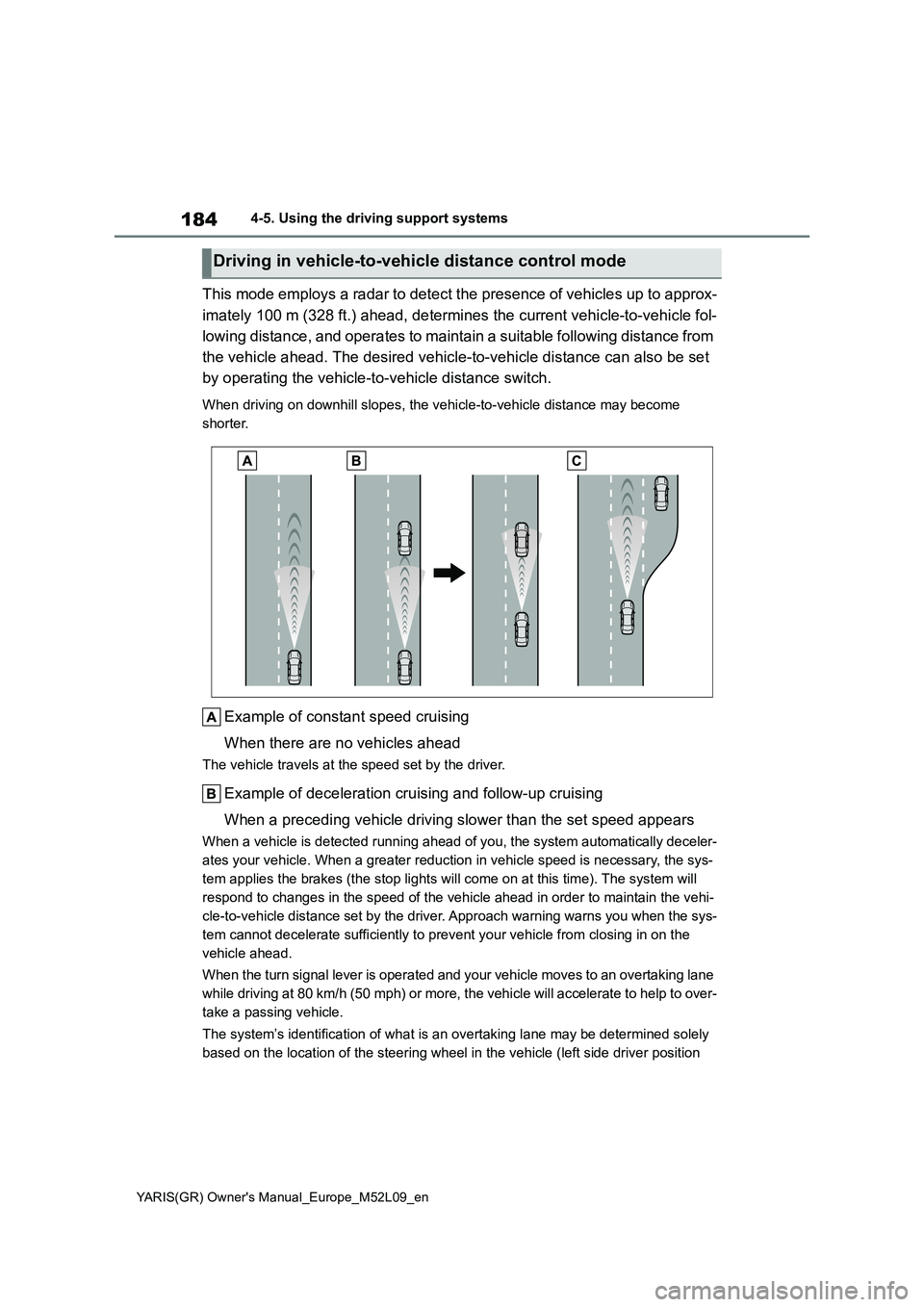
184
YARIS(GR) Owner's Manual_Europe_M52L09_en
4-5. Using the driving support systems
This mode employs a radar to detect the presence of vehicles up to approx-
imately 100 m (328 ft.) ahead, determines the current vehicle-to-vehicle fol-
lowing distance, and operates to maintain a suitable following distance from
the vehicle ahead. The desired vehicle-to-vehicle distance can also be set
by operating the vehicle-to-vehicle distance switch.
When driving on downhill slopes, the vehicle-to-vehicle distance may become
shorter.
Example of constant speed cruising
When there are no vehicles ahead
The vehicle travels at the speed set by the driver.
Example of deceleration cruising and follow-up cruising
When a preceding vehicle driving slower than the set speed appears
When a vehicle is detected running ahead of you, the system automatically deceler-
ates your vehicle. When a greater reduction in vehicle speed is necessary, the sys-
tem applies the brakes (the stop lights will come on at this time). The system will
respond to changes in the speed of the vehicle ahead in order to maintain the vehi-
cle-to-vehicle distance set by the driver. Approach warning warns you when the sys-
tem cannot decelerate sufficiently to prevent your vehicle from closing in on the
vehicle ahead.
When the turn signal lever is operated and your vehicle moves to an overtaking lane
while driving at 80 km/h (50 mph) or more, the vehicle will accelerate to help to over-
take a passing vehicle.
The system’s identification of what is an overtaking lane may be determined solely
based on the location of the steering wheel in the vehicle (left side driver position
Driving in vehicle-to-vehicle distance control mode